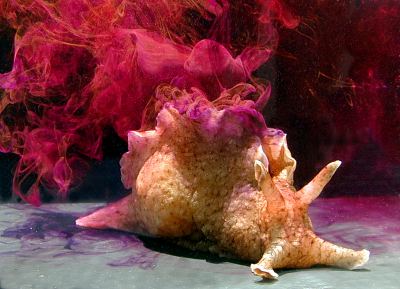- Sea hare
Taxobox
name = Sea Hares

image_width = 200px
image_caption = "Aplysia californica ", a typical sea hare
regnum =Animal ia
phylum =Mollusca
classis =Gastropoda
subclassis =Orthogastropoda
superordo =Heterobranchia
ordo =Opisthobranchia
subordo = Anaspidea (=Aplysiomorpha)
subordo_authority = P. Fischer, 1883
subdivision_ranks = Families
subdivision =
*SuperfamilyAkeroidea
**Akeridae
*SuperfamilyAplysioidea
**Aplysiidae Sea hares ("Aplysia" species and related genera) are very large sea
slug s with a soft internal shell made of protein. These are marinegastropod mollusc s in the familyAplysiidae and superfamilyAplysioidea .The
common name "sea hare" derives from their rounded shape and from the two longrhinophores that project upwards from their heads and that somewhat resemblerabbit ears.The original author P. Fischer described this taxon at unspecified rank above family [cite book | title=Manuel de conchyliologie et de paléontologie conchyliologique fasc. 6| last=Fischer| first=P.| date=1883| pages=p. 513-608| publisher=Savy | location=Paris] . In 1925 Thiele established this taxon as a suborder. Since the taxon Anaspidea was not based on an existing genus, this name is no longer available. It has been replaced in the new
Taxonomy of the Gastropoda (Bouchet & Rocroi, 2005) by theclade Aplysiomorpha .The scientific name for the order in which they are classified, the (Anaspidea), is derived from the Greek for "without a shield" and refers to the lack of the characteristic head shield found in the cephalaspidean opisthobranchs. Many anaspideans have only a thin, internal and much-reduced shell with a small mantle cavity; some have no shell at all. All species have a
radula and gizzard plates.Description
Sea hares are mostly rather large, bulky creatures. The biggest species, "
Aplysia vaccaria ", can reach a length of 75 cm and a weight of 2 kg and is arguably the largest gastropod species.Sea hares have soft bodies with an internal shell, and like all opistobranch mollusks they are hermaphroditic.
Life habits
Sea hares are herbivore/herbivorous, and are typically found on seaweed in shallow water. It seems to be the case that some young sea hares are capable of burrowing in soft sediment leaving only their rhinophores and mantle opening showing. Sea hares have an extremely good sense of smell. They can follow even the faintest scent using their
rhinophores , which are extremely sensitive chemoreceptors.Their color corresponds with the color of the seaweed they eat: red sea hares have been feeding on red seaweed. This
camouflage s them from predators.When disturbed, a sea hare can release ink from its ink glands, providing a potent deterrent to predators. This release acts as a smoke screen, while at the same time, adversely affecting the smell sensors of their predators. In a small environment, this ink could be toxic to the inhabitants. The color of the ink is white, purple or reddish, depending on the color of the pigments in their seaweed food source. Their skin contains a similar toxin that renders sea hares largely inedible to many predators.
Human use
"Aplysia californica" is a typical example of a sea hare, and is noteworthy for its usefulness in studies of
neurobiology because of the unusually large size of the axons that are a part of its nerve cells.Notes
References
* http://www.seaslugforum.net/display.cfm?id=4210
* http://www.cabrilloaq.org/critter1.html
Wikimedia Foundation. 2010.
